Compression Pressure Inspection
|
If the there is lack of power, excessive oil consumption
or poor fuel economy, measure the compression pressure.
|
|
1. |
Warm up and stop engine.
Allow the engine to warm up to normal operating temperature.
|
|
2. |
Disconnect the injector extension connector (A) and
ignition coil connectors (B).
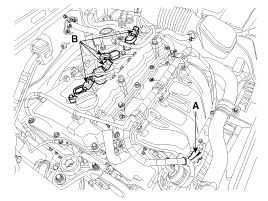
|
|
3. |
Remove ignition coils (A).
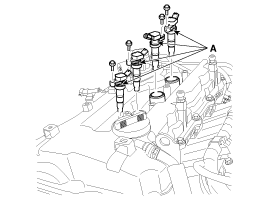
|
|
4. |
Remove spark plugs.
Using a 16mm plug wrench, remove the 4 spark plugs.
|
|
5. |
Check cylinder compression pressure.
|
(1) |
Insert a compression gauge into the spark
plug hole.
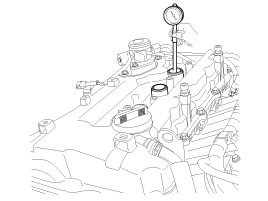
|
|
(2) |
Fully open the throttle.
|
|
(3) |
While cranking the engine, measure the compression
pressure.
|
Always use a fully charged battery
to obtain engine speed of 200 rpm or more.
|
|
|
(4) |
Repeat steps (1) through (3) for each cylinder.
|
This measurement must be done in
as short a time as possible.
|
Compression
pressure :
1,324kPa (13.5kgf/cm², 192psi) /
200 ~ 250rpm
Minimum
pressure :
1,177kPa (12.0kgf/cm², 171psi)
Difference
between each cylinder :
100kPa (1.0kgf/cm², 15psi) or less
|
|
|
(5) |
If the cylinder compression in 1 or more
cylinders is low, pour a small amount of engine oil into the
cylinder through the spark plug hole and repeat steps (1) through
(3) for cylinders with low compression.
| A. |
If adding oil helps the compression,
it is likely that the piston rings and/or cylinder bore
are worn or damaged.
|
| B. |
If pressure stays low, a valve may
be sticking or seating is improper, or there may be
leakage past the gasket.
|
|
|
|
6. |
Reinstall spark plugs.
|
|
7. |
Install ignition coils.
|
|
8. |
Connect the injector extension connector and ignition
coil connectors.
|
|
9. |
Some DTC's may exist after the inspection test and
may need to be manually cleared with GDS.
|
Valve Clearance Inspection And Adjustment
|
Inspect and adjust the valve clearance when the engine
is cold (Engine coolant temperature : 20°C (68°F)) and cylinder head
is installed on the cylinder block.
|
|
In case of removing the high pressure fuel pump,
high pressure fuel pipe, delivery pipe, and injector, there may be injury
caused by leakage of the high pressure fuel. So don’t do any repair
work right after engine stops.
|
|
1. |
Remove the cylinder head cover. (Refer to Timing
system in this group)
|
|
2. |
Set No.1 cylinder to TDC/compression.
|
(1) |
Turn the crankshaft pulley and align its
groove with the timing mark "T" of the lower timing chain cover.
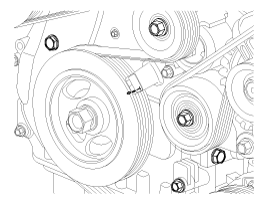
|
|
(2) |
Check that the TDC marks (A) of the CVVT
sprockets are in straight line on the cylinder head surface
as shown in the illustration.
If not, turn the crankshaft one revolution
(360°)
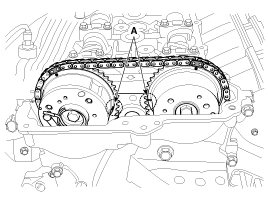
|
|
|
3. |
Inspect the valve clearance.
|
(1) |
Check only the valve indicated as shown.
Measure the valve clearance.
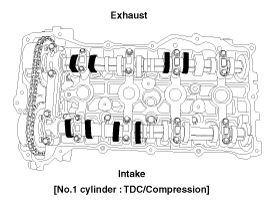
| A. |
Using a thickness gauge, measure
the clearance between the tappet and the base circle
of camshaft.
|
| B. |
Record the out-of-specification valve
clearance measurements. They will be used later to determine
the required replacement adjusting tappet.
|
Valve clearance
Specification
Engine coolant temperature : 20°C
[68°F]
Limit
Intake : 0.10 ~ 0.30mm (0.0039 ~
0.0118in.)
Exhaust : 0.20 ~ 0.40mm (0.0079 ~
0.0157in.)
|
|
|
(2) |
Turn the crankshaft pulley one revolution
(360°) and align the groove with timing mark "T" of the lower
timing chain cover.
|
|
(3) |
Check only valves indicated as shown. Measure
the valve clearance.
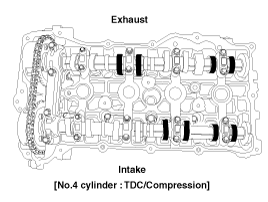
|
|
|
4. |
Adjust the intake and exhaust valve clearance.
|
(1) |
Set the No.1 cylinder to the TDC/compression.
|
|
(2) |
Mark the timing chains (A) on the timing
marks of the CVVT sprockets.
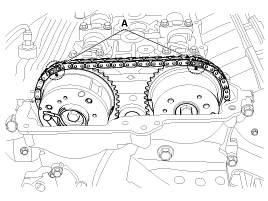
|
|
(3) |
Remove the front camshaft bearing cap.
|
|
(4) |
Turn the crankshaft pulley 15° clockwise.
|
|
(5) |
Remove the service hole bolt(A) of the timing
chain cover.
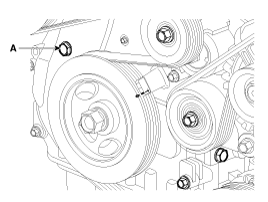
|
The bolt must not be reused once
it has been assembled.
|
|
|
(6) |
Release the ratchet of the timing chain tensioner
by pulling the link down using a thin rod.
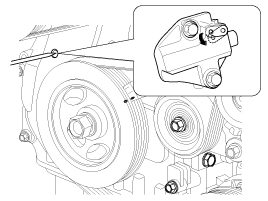
|
|
(7) |
Remove the exhaust camshaft bearing cap and
exhaust camshaft.
|
|
(8) |
Remove the intake camshaft bearing cap and
intake camshaft.
|
When disconnect the timing chain
from the CVVT sprocket, hold the timing chain.
|
|
|
(9) |
Tie down timing chain so that it doesn't
move.
|
Be careful not to drop anything inside
timing chain cover.
|
|
|
(10) |
Measure the thickness of the removed tappet
using a micrometer.
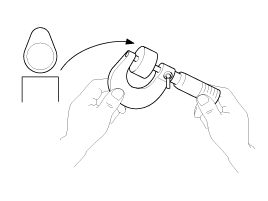
|
|
(11) |
Calculate the thickness of a new tappet so
that the valve clearance comes within the specified value.
Valve clearance
[Engine coolant temperature : 20°C(68°F)]
T : Thickness of removed tappet
A : Measured valve clearance
N : Thickness of new tappet
Intake : N = T + [A - 0.20mm (0.0079in.)]
Exhaust : N = T + [A - 0.30mm (0.0118in.)]
|
|
|
(12) |
Select a new tappet with a thickness as close
as possible to the calculated value.
|
Shims are available in 47 size increments
of 0.015mm (0.0006in.) from 3.00mm (0.118in.) to 3.690mm
(0.1452in.)
|
|
|
(13) |
Place a new tappet on the cylinder head.
|
|
(14) |
Hold the timing chain, and install the intake
camshaft and CVVT assembly.
|
|
(15) |
Align the timing marks (A) on the timing
chains and CVVT sprockets.

|
|
(16) |
Install the exhaust camshaft and CVVT assembly
after releasing the ratchet of the timing chain tensioner.
|
|
(17) |
Install the front bearing cap.
|
|
(18) |
Install the service hole bolt.
Tightening
torque :
11.8 ~ 14.7N.m (1.2 ~ 1.5kgf.m, 8.7
~ 10.8lb-ft)
|
|
|
(19) |
Turn the crankshaft two turns in the operating
direction(clockwise), and then check that the TDC marks (A)
of the CVVT sprockets are in straight line on the cylinder head
surface.

|
|
(20) |
Recheck the valve clearance.
Valve clearance
[Engine coolant temperature : 20°C(68°F)]
[Specification]
Intake : 0.17 ~ 0.23mm (0.0067 ~
0.0090in.)
Exhaust : 0.27 ~ 0.33mm (0.0106 ~
0.0129in.)
|
|
|
Specifications
Description
Specifications
Limit
General
Type
In-line, DOHC
Numbe ...
Troubleshooting
Symption
Suspect area
Remedy
Engine misfire with abnormal internal lower engine noises.
Worn crankshaft bearings
Lo ...
See also:
Eco Coach
• What is Eco Coach?
Every 2.5 minutes, Eco Coach compares your fuel economy against the government
tested average (EPA) or other similar Hyundai models (community), based on your
preference. ...
Automatic Transaxle. Components and Components Location
Components (1)
Components (2)
1. Automatic transaxle case
2. Low & reverse brake piston
3. Low & reverse brake return spring
4. Snap ring
5. Front annulus ...
Catalytic Converter. Description and Operation
Description
The catalytic converter of the gasoline engine is a three way catalyst.
It oxidizes carbon monoxide and hydrocarbons (HC), and separates oxygen from
the oxides of nitrogen (NOx). ...
 Hyundai Sonata: Repair procedures
Hyundai Sonata: Repair procedures Specifications - Revised
Specifications - Revised Troubleshooting
Troubleshooting










